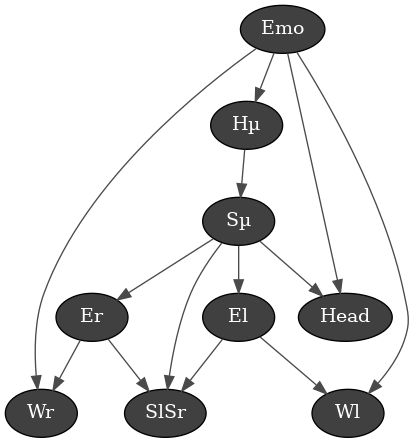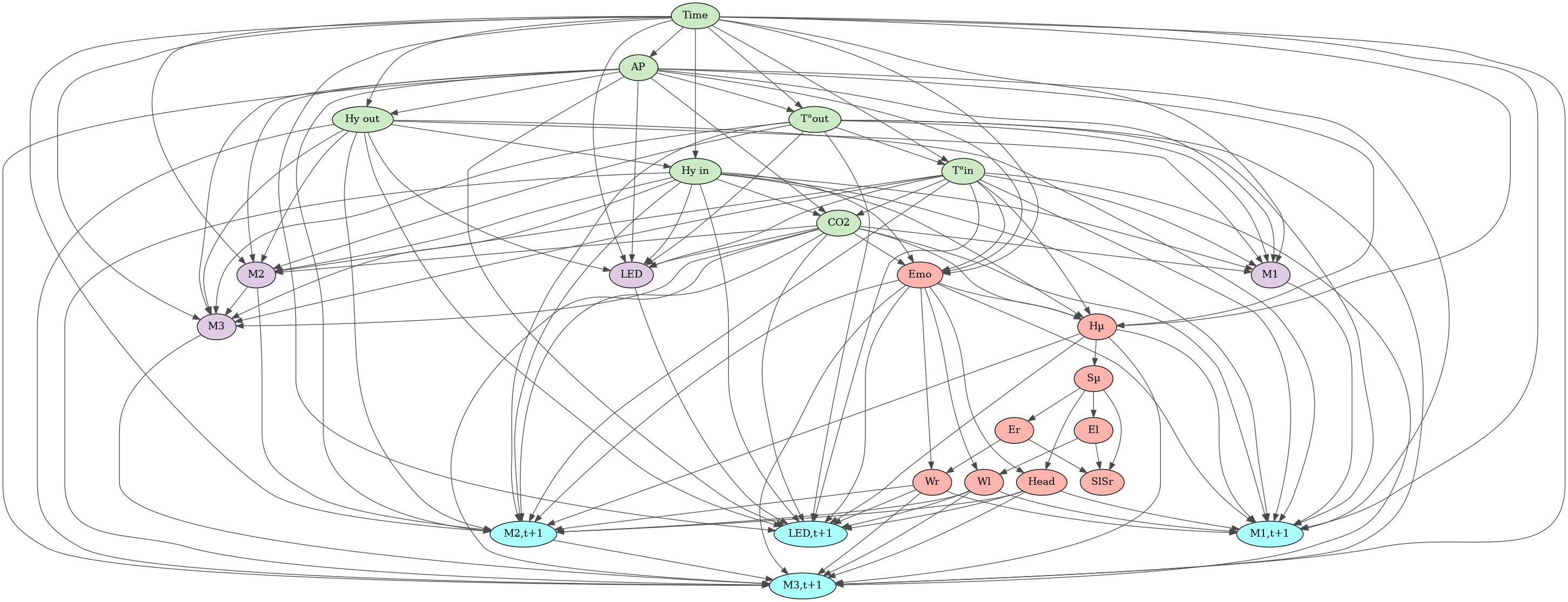Behaviours from World Data
- Temperature (inside/outside) : {-20 ; 50}
$\pm$ 5 °C ==> 14 classes - Humidity (inside/outside) : {0 ; 100}
$\pm$ 5 % ==> 20 classes - Atmospheric pressure : {850 ; 1050}
$\pm$ 50 hPa ==> 4 classes - CO$_2$ concentration : {200 ; 1200}
$\pm$ 200 ppm ==> 5 classes - Emotions : {'neutral', 'happy', 'sad', 'surprise', 'anger'} ==> 5 classes
- Body position : 18*2 values
Total state (without Body Positions) :
- Motor 1 (base) : {-10 ; 0 ; +10} ==> 3 classes
- Motor 2 (head bow) position : {-10 ; 0 ; +10} ==> 3 classes
- Motor 3 (head yaw) position : {-10 ; 0 ; +10} ==> 3 classes
- LED Red : {-10 ; 0 ; +10} ==> 3 classes
- LED Green : {-10 ; 0 ; +10} ==> 3 classes
- LED Blue : {-10 ; 0 ; +10} ==> 3 classes
- LED Luminosity : {-10 ; 0 ; +10} ==> 3 classes
Total actions:
With
Let's see the relationship of the parameters of each state, independently of the other states.
We can draw the Directed Acyclic Graph (DAG) as follow:
We can assume that all world data, i.e. meteorological data, are a function of the current time. Since Yokobo is working with a quite short time approach, we disregarded the current date, which has also an influence. Then, the atmospheric pressure influences the temperatures, humidity data and CO2 level. The latter is also related to inside humidity and temperature.
Since the data of the weather station are updates every 10 min on the server:
We can draw the DAG as follow:
The position of the motors and the LED colour are independent, besides the link that exists between M2 and M3.
We can draw the DAG as follow:
With Hµ the mean position between the two hips; Sµ the mean position between the two shoulders; El and Er the left/right elbow position; Wl and Wr the left/right wrist position; SlSr the horizontal distance between the two shoulders.
With this graph, we define the hip as the origin of the body, the point that defines the positions of the others. Because for the interaction we have with Yokobo the position of the hips and extremities is not important, we can use the mean position. However, for the shoulders, the positions of the left and right are important. Because we are using DAG, we cannot use the position of each shoulder, since we would have a cycle. Then, to overcome this problem, we can add the length between the two shoulders (SlSr), and we can assume it does not influence Sµ. We also hypothesise that the emotion of the person mostly influences the position of their hands and head and the rest of the body through the hips.
The goal of the Bayesian Network is to remember and predict the future state of the robot (
Since we want to see the possible state of the robot, according to the current observation of the world, the current state of Yokobo (
To simplify the connections, some hypotheses are made. First, since the user is interacting with Yookobo inside the home, the temperature and humidity outside are not affecting the user. Then, the connection to the user (to




